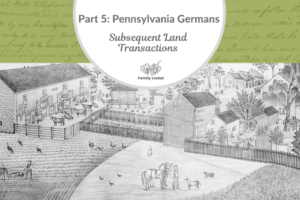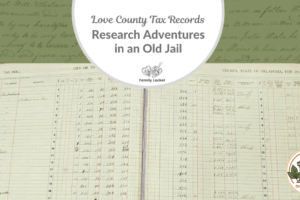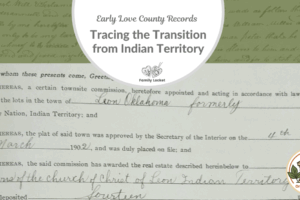
What can you find at the county courthouse? Records kept on the county level, such as deeds, mortgages, marriages, wills, guardianships, etc., are vital for our research. Although many of these items may be available online, some likely exist only at the courthouse. A trip to the courthouse may be in order if we want to perform reasonably exhaustive research.
I recently visited Chambers County, Alabama, the residence of my ancestor, Thomas Beverly Royston, from about 1842 to his death in 1868. I had gathered many records from online sources such as Ancestry and FamilySearch. Still, I wanted to look at original records and see if I could discover additional information about his life and family. Here are some tips based on my experience.
Preparation
Before spending time at the courthouse, create a research plan. If you’ve created a timeline for the ancestor, you will have a good idea about the years to search for land, tax, marriages, probate, etc. Printing your timeline will give you a good reference point for any records you locate. Since you don’t know specifically what records will be available, you can list all the possibilities. In my case, I had already located many land records on FamilySearch microfilm, but the copies were not good, and I wanted to obtain originals if possible.
If possible, learn what records are available at the courthouse that are not online. Of course, you may have to do this yourself once you’re on-site. Some courthouses have a website detailing their historical records, but others may not. Although the Chambers County website has information for its citizens and their current needs, there is no page for the archives or records room.
A fellow researcher had visited the courthouse a few months before me and kindly noted the various types of records. She also sent a picture of the large books on shelves and the ladder used to access them, so I was more prepared than if I would have been otherwise.
When planning your visit, it is essential to know the courthouse’s opening hours and call ahead to ensure it is open. The website will provide the hours and phone number needed.
Research at the Courthouse
 Be prepared for anything when visiting the courthouse and dress in layers. It may be cold, hot, or just right in the records room. I was surprised that I had to go through a security checkpoint before entering, but once through, I was directed to the exact room where I could spend the next few hours. The books were shelved from floor to ceiling, so I did a quick overview to see what was available.
Be prepared for anything when visiting the courthouse and dress in layers. It may be cold, hot, or just right in the records room. I was surprised that I had to go through a security checkpoint before entering, but once through, I was directed to the exact room where I could spend the next few hours. The books were shelved from floor to ceiling, so I did a quick overview to see what was available.
Armed with my list and phone camera, my assistant (husband) and I went to work pulling volumes, finding records, and taking photos. I quickly located the original index books and loved scanning through them for the Royston surname. I previously did this via FamilySearch microfilm but missed a few key entries.
I was excited to find the record where my ancestor, Robert C. Royston, and his brother, Joseph, sold the land they inherited from their father upon his death. The index entry listed “Joseph Royston et al” at the bottom of the page; I hadn’t noticed it in my previous research.1 Locating the record in the deed book, I saw that it was the deed I hoped to find.2
Challenges
One of the challenges I ran into during my courthouse research was differentiating between mortgage and deed records. Since both were grouped together in the indexes, I thought they would all be in the deed books. However, after doing multiple searches in the deeds books for the mortgage record of C. Royston, I gave up and thought the records were lost or mis-indexed. When I returned home and started entering my research into my Airtable research log, I took a closer look and discovered the M that signalled a mortgage record. I realized that there are separate books for these! Now I need to contact the courthouse and ask them to find the four records I missed.
The lesson to learn? Don’t assume anything and look as closely as you can at the indexes and book titles.
Tracking Research at the Courthouse
You need a sound system to ensure you can create the appropriate source citations once you return home, so here is my process.
- Use the index books to find each record and note the volume and page number in a printed research log or notebook. This becomes a mini research plan.
- Find the record in the appropriate book
- Photograph the cover of the book or the inside flap – or both
- Photograph all the records from the book
- Repeat for each book
As you complete each search, mark it off your research log and make any notes you’ll need when transferring to your digital research log at home.

Record Images on Google Photos
After the Courthouse
When you’ve returned home, pull out your research log/notebook and photographs of the records and enter them into your digital research log. Here is my process:
- Create the source citation in the research log for each record based on the photo of the book cover, the repository, and the recorded event.
- Add the relevant information to the research log – an abstract of the information, comments on the source, information, and evidence, etc.
- Download the record image to my ancestor’s folder on Google Drive, giving it the appropriate name. I use the date> record type > name > locality protocol.
- Attach the source citation to the front of the image using a program like Canva or Windows Designer. (See example above of the Royston to Buckalew index and deed.)

Entry for the Royston to Buckalew Deed Research Log Entry
Use the Research Findings
With the new findings, you can add to your research summary or report for the ancestor. Perhaps you’ve answered your research question or found new questions. Let your findings guide your next research project; remember, you can always return to the courthouse for another round of research!
Best of luck in all your genealogical research!
Sources
- Chambers County, Alabama, Direct Index to Records of Deeds, Mortgages, and other instruments, Joseph Royston et al, deed, 15: 300,1869, Chambers County Courthouse, La Fayette, Alabama.
- Chambers County, Alabama, Deed Record 15 Pages 1 – 304, Joseph and R.C. Royston to A.A. Buckalew, 27 September 1869, Chambers County Courthouse, La Fayette, Alabama.




















6 Comments
Leave your reply.